Rules for compiling a memorandum on non-fulfillment of official duties by an employee + design examples + useful tips and nuances of drafting a document
Memorandum on non-fulfillment of official duties: a sample form and an example of filling out a form is the topic of our today's review. Every employer faces such a situation as improper performance of duties by employees. Therefore, you need to know how to deal with such situations, how to prevent ignoring labor discipline and maintain a harmonious working environment in the team. After all, for this it is necessary that each employee qualitatively and timely fulfill all his professional duties, the result of the overall work depends on this.
The simplest and most effective method for such problematic situations is a memo (memorandum), which allows the employee to present well-reasoned official claims, to make him liable for improper performance of professional duties. With the help of such a note, you can make the employee think about his inappropriate behavior, for example, by announcing a remark or reprimand to him. Also, such a document may be the basis for the dismissal of an employee on appropriate grounds, one of the articles of the labor code.
The memorandum serves as a tool for officially informing the head of the organization about the improper performance by a particular employee of his duties, which often has serious consequences for the organization, often in the form of significant material damage, as well as the imposition of disciplinary liability on the employee. In such cases, internal audits are often carried out. And if there is damage, someone should be held responsible for it, thus, with the help of a memorandum, you can officially inform the management about the fault of a particular employee for what happened. Based on this document, an order is already being issued to impose disciplinary or other liability on the offending employee.
Thus, this paper is the basis for a decision on the responsibility of a particular person who made a serious mistake. Let us consider in detail how to properly draw up such a report, and what nuances should be taken into account when compiling it.
When hiring a new employee, his immediate supervisor or an employee of the personnel department is obliged to familiarize the employee with all the rules in force in the organization. In addition, some organizations also have additional internal procedures or rules of corporate ethics. In organizations where hiring was carried out in compliance with all necessary procedures, fewer questions and unpleasant situations arise in the course of work regarding the duties of employees and their compliance with labor discipline.
The employee's job description and the general rules of corporate ethics or other similar documents clearly spell out all the duties of employees and their rights. An employee of the organization must follow the established rules and understand that their non-compliance, in the long run, can lead to material damage to the organization, for which he will have to be responsible. But there are still cases when employees do not pay due attention to their direct duties, this may negatively affect the activities of some department or division of the organization, the company may suffer losses. And then, the immediate supervisor of the delinquent employee must inform the higher management about the fact that happened, indicate whose actions led to the occurrence of an unpleasant situation, and who should be responsible for the negative consequences.
In such cases, the immediate supervisor submits a memorandum to the higher management, in which he describes the fact of what happened and indicates the person who did not fulfill his duties properly. There may also be a situation when an employee systematically does not perform his duties properly and other employees must perform part of his duties or correct his mistakes, such cases should also be brought to the attention of management.

Memorandum on non-fulfillment of official duties - general provisions
A memorandum (official) note is, in fact, an information document in which the manager is informed about the improper performance by the employee of his professional duties, and this note is also the basis for imposing a disciplinary sanction on the offender. The memorandum usually sets out the facts confirming the unfair performance by the employee of his professional duties and a request is made to apply liability measures to the offender. Measures of responsibility can be: a remark, a reprimand, and sometimes even dismissal on the relevant grounds of the labor code.
Note that the report is drawn up by the line manager (head of the unit), only if there are good reasons and evidence of the employee’s intentional unwillingness to perform his job duties or of the facts of gross repeated failure to fulfill his duties and the employee’s lack of weighty arguments in his justification - a weighty reason. It is this evidence that serves as the basis for compiling a memorandum.
Therefore, until all the circumstances of the incident are clarified, a report is not drawn up.
And we especially note that only after analyzing all the facts of what happened, it is the immediate supervisor of the offender, and no other person, who decides to draw up a report, draws it up and submits it to a higher manager or director of the organization, usually through a secretary. On the basis of a report, a delinquent employee may be fined, reprimanded or otherwise subjected to punishment. If an employee already has several reports, he may be fired under an unsightly article of the labor code.
The current legislation does not provide for a unified form for reports of this kind. However, when drawing up a document, one should adhere to the general provisions for office work. The note is drawn up manually or on a computer. General design rules:
- At the top right, first the full name of the addressee is indicated, namely: the position of the person and the name of the organization, full name;
- Name and position of the applicant;
- Further in the center of the sheet is the heading “Memorandum” and usually the essence is briefly indicated in the second subheading - “on failure to perform official duties”;
- Further, the text follows, with a list of outstanding duties;
- bringing evidence and arguments about the guilt of the employee, conclusions;
- proposals for measures of responsibility for the offending employee;
- signature, position of the applicant, full name, date of preparation of the paper.
Since there is currently no clearly defined and unified uniform form of the document, some deviations from the above template are possible. Such paper can also be considered valid.
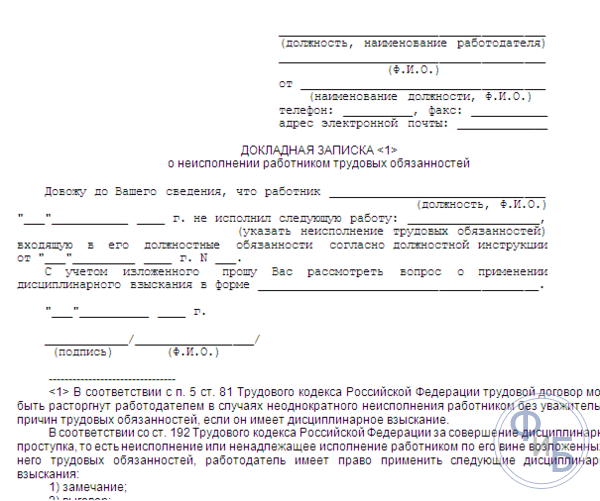
Usually, the compiled paper is handed over to the secretary, who registers it and puts on it the serial number of the document and the date of acceptance. Then the document is transferred to the director or other higher managerial person.
Such documents must be registered with the organization, since the note contains official information that has legal consequences. Let's talk about the methods and order of registration in a little more detail.
Typically, one of the following forms is used to register important documents in an organization:
- Journal form. The organization has a special accounting journal in which information is entered on all internal official documents of the organization. A new document is assigned a serial number, then line-by-line entries are made manually in the journal in chronological order, indicating the brief details of the documents. Automatic form. The document is compiled on a computer and immediately entered into the electronic document management database.
- Card form. For each document, a separate card is created with a registration number and an indication of the details of the note. The card is then placed into the classifier. This method is usually used in departmental institutions.
Specific features of memos
The purpose of the memorandum (memorandum) is to convey to the higher management a request for the application of disciplinary measures to the offending employee. The report must contain confirmed facts that reflect the improper non-fulfillment by the employee of his direct professional duties.
Documents supporting the applicant's arguments can be attached to the note. These can be, for example, papers incorrectly drawn up by an employee, CCTV recordings and other evidence. According to the facts indicated in the note, an official check can be carried out. Based on the results of consideration of the note and the verification actions carried out, a decision is made on the measures of responsibility of the offending employee, in the form of disciplinary liability (remarks, administrative reprimand) or even dismissal of the employee under the relevant article of the Labor Code. This decision is made in the form of an order of the head of the organization.
As noted earlier, a note is compiled and considered by the top management of the organization only if the employee has not followed the direct instructions of his line manager or his current professional duties, without any good reason. In the event of a dispute, an internal internal audit must be carried out.
If the organization already has developed special forms or templates for such documents, in this case they should be used. The note can be filled out by hand on a form, on a computer, or written entirely by hand.
Sometimes in the internal regulations of the organization it is indicated that the report on non-fulfillment of professional duties must be agreed with certain officials. The prescribed internal procedure must be observed, otherwise the note will not be accepted by the director or other higher official.
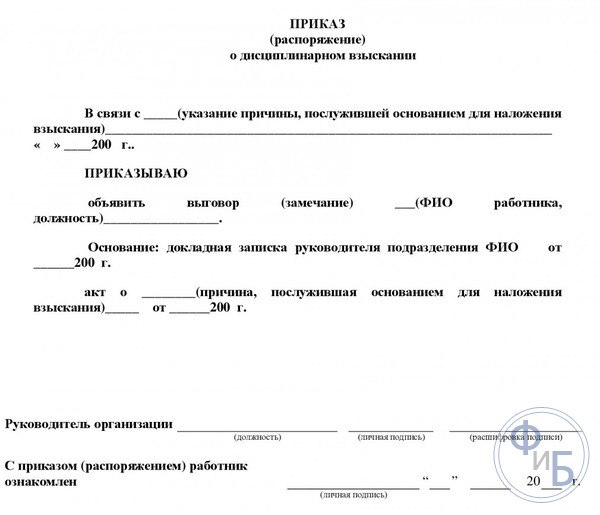
As we have already said, the report on non-fulfillment of professional duties actually contains a request to impose liability measures on the delinquent employee. If the superior manager made a positive decision that the employee of the company should be held responsible for his mistake, then the employee bears a certain punishment for his act, which is assigned to him by the management of the organization in order to prevent such repeated situations.
But it happens that a delinquent employee understands and admits the fallacy of his behavior or actions committed by him, as a result of which he quickly corrects himself, strives not to make such mistakes in the future, tries to make more efforts to fulfill his duties, trying to rehabilitate himself and regain confidence. In such cases, the line manager (boss) of the delinquent employee may well file a service requesting the removal of the penalty or other easing in the punishment of the employee. Such a document is drawn up like a report on non-fulfillment of duties.
Let's consider in detail what exactly needs to be specified:
- position of the head and name of the organization, full name;
- position of the compiler of the note, full name;
- title "Memorandum";
- the following is a link to the order to impose a penalty on the employee, indicating the date and number of this order;
- give facts about the new labor successes of the employee and the reasons for canceling the punishment;
- a request to cancel disciplinary measures ahead of time or mitigate the punishment;
- the name and position of the compiler of the memorandum;
- date of preparation of the document, signature of the applicant.

Conclusion
At the moment, Russian legislation does not provide for any specific unified form or form for such memos, but organizations themselves have the right to draw up forms (templates) for such purposes.
When compiling such documents, one should be guided by the generally accepted rules of office work, indicate all the necessary details. Compliance with these simple rules will help to avoid disputes or even conflict situations.
In the text of the document, it is necessary to clearly indicate which job duties the employee did not fulfill, provide evidence of this fact and the consequences of his actions, and propose measures of responsibility for the offending employee.
Note that not a single team can do without violations of duties or labor discipline, therefore, the management team should know the basic rules for compiling such documents, and employees should be aware of the measures of responsibility, in case of failure to fulfill their official duties.
We analyzed the basic rules and the design of the report on improper performance of duties, examined the various nuances that arise in such situations. The document itself is not difficult to compile, one might say, it is drawn up in an arbitrary form. However, some points need to be known and considered. We also told you what important circumstances of what happened must be taken into account before compiling such a service at all.
Indeed, in most cases, a simple, well-made remark to an employee is enough. Or maybe you just need to figure out the reasons why the employee was unable to adequately fulfill his duties, this also happens often and not always the reasons lie on the surface. Sometimes it is necessary to change the scheme of work in a given labor area, to make adjustments to the established procedure, due to a change in the economic situation, or maybe the production process needs to be adjusted.
 Ready-made business plan with calculations using the example of a web studio
Ready-made business plan with calculations using the example of a web studio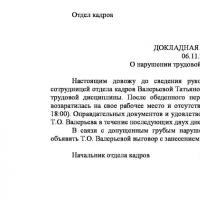 Registration of an internal memorandum: sample document and drafting rules
Registration of an internal memorandum: sample document and drafting rules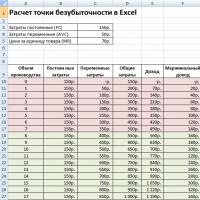 Break even. Formula. Example of model calculation in Excel. Advantages and disadvantages
Break even. Formula. Example of model calculation in Excel. Advantages and disadvantages Advance report is ... Advance report: sample filling
Advance report is ... Advance report: sample filling How to stitch documents with threads by hand?
How to stitch documents with threads by hand?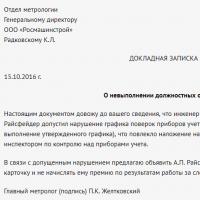 Disciplinary sanction for non-fulfillment of official duties
Disciplinary sanction for non-fulfillment of official duties Binding your book
Binding your book